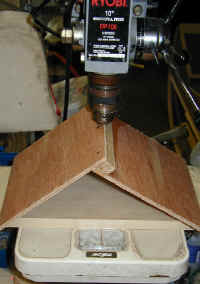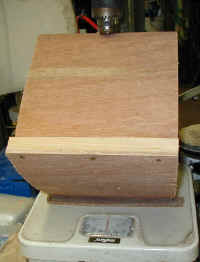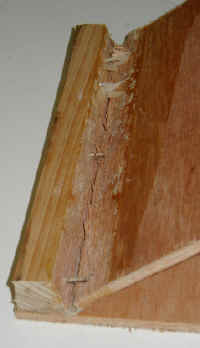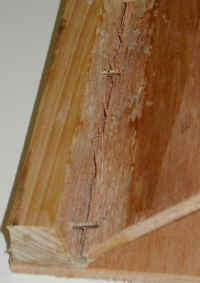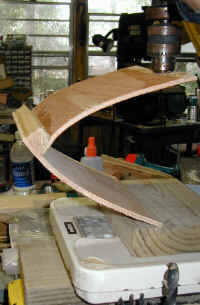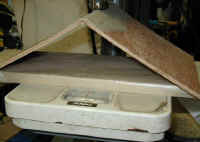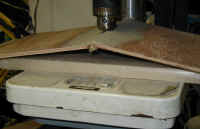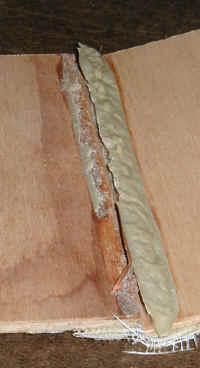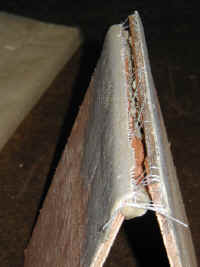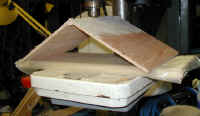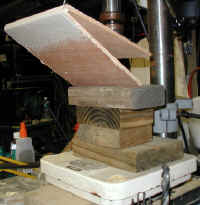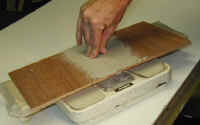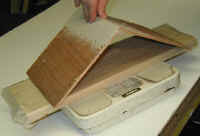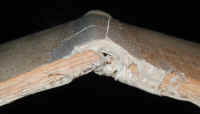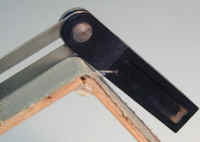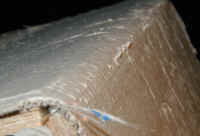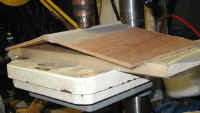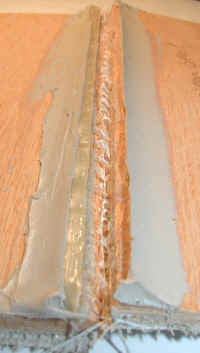| Alternative ply joint tests ... |
Here I will be creating various test joints to simulate a side bottom joint in a small boat, and then stress test them in a variety of ways and report the results. For those of you unfamiliar with PL Premium polyurethane adhesives - they are construction adhesives related to 3M 5200 but much less expensive. See our PL Premium page for statistics and testimonial.
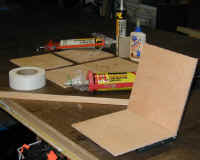
|
9/2/02
The first material I am using is 1/4" exterior luan plywood. (3 ply - 1 thick inner ply and 2 thin outer plies.) Partly because many small home built boats are made from it, and partly due to it being cheap and available. The ply is cut into 8" squares, and the joints are made at a 15 degree angle. (To simulate average small boat flare.) |
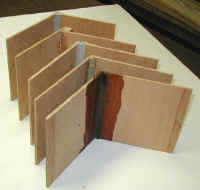
|
I'm testing 6 joints to start with. 1. Epoxy and Glass inside and out. 2. Chine log and bronze ring nails and PL Prem. & Titebond II (for log/side joint) 3. Same as 2 except all PL Premium glue used on both panels. 4. PL Prem. fillet inside & PL Prem. and mesh drywall tape outside 5. PL Masonry fillet inside & PL Mas. and mesh drywall tape outside 6. PL Prem. bead inside & PL Mas. and mesh tape outside (Then a PL Mas. fillet is spread over the inner bead after it cures.) For details on the construction of these panels go to this page. |
Stress testing the assemblies:
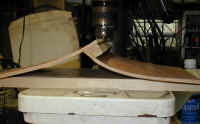
|
I was surprised to find that it only took 80 lbs of pressure to extend the 3" travel of the drill head. You can see the amount of flex in the ply panels. There was no sound or sign of failure. |
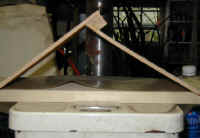
|
When I released the pressure, the joint assembly rebounded to within 1/8" of its starting position. |
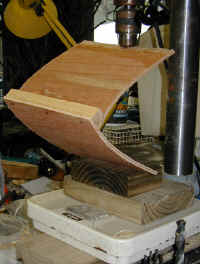
|
Using a bevel gauge I know this piece flexed to approximately a 60 degree angle at about 80 lbs of pressure before it failed with a rather loud CRACK. |
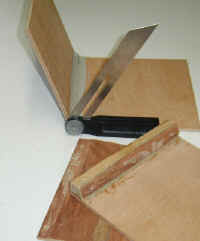
|
The test piece and the bevel gauge in the background shows the amount of flex that occurred before failure. The flex was around 45 degrees before failure. |
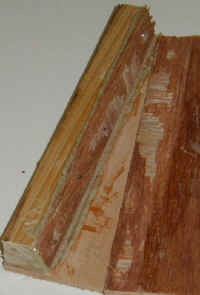
|
What failed was the exterior ply of the plywood and in some places the factory glue joint between the outer and inner plies. |
#1 The epoxy glass joint handled the tent test without failure though it emitted crackling sounds. It required greater propping (pre loading) then the others - continued to crackle but did not fail. Interestingly the assembly seemed to be absorbing the downward pressure during the press travel as the scale never read more than slightly above 40 lbs. With the cracking I assume there was a relaxing of tensions in the piece as the scale reading gradually went down.
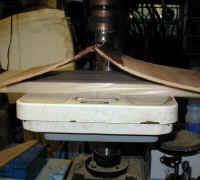 |
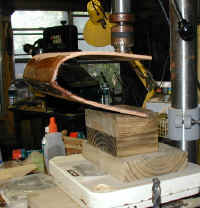 |
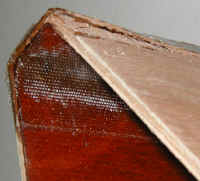 |
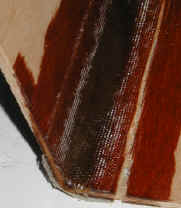 |
Since I could not produce failure on the press, I placed the joint on the floor and stood on it. First in the "tent" position (no failure) then in the "book close" position. With my full weight (180 lbs) the ply ruptured at the edge of the joint.
|
I sent out this report to a bunch of boat builders
and designers on the web with a plea for help interpreting these
results.
If you only consider how much force is required to first distort and then rupture a joint, epoxy is the clear winner with the PL Premium and chine log the runner up. The worst performer was the PL Premium fillet inside and PL Premium and mesh tape outside. It failed with very little effort.
The PL Masonry joints are harder
to interpret because they were so flexible they were near impossible to
get to rupture, requiring repeated extreme flexing, as in {"fully
closing a book" or "opening a book past flat." The tricky
part is that the forces necessary to flex these joints was low - in the
10 lb range, as opposed to the epoxy which required 180 lbs, and chine
logs 80 lbs. However both epoxy and chine log joints held so well that
the plywood fibers ruptured. This reflects all modern glue
advertisements of "the glue joint is stronger than the
wood!" Which seems like a good thing.
However, the PL Masonry flexed so
much it absorbed all the force and didn't pass it on to the wood, and
for the longest time, neither the glue joint nor the wood failed,
returning repeatedly to its pre stressed state. After repeated extreme
flexing I was able to get the glue to fail, but only by asking it to
bend in ways that it could never bend while incorporated into a boat
hull.
I imagine there are up sides
and down sides to this. These joints could potentially withstand great
stress and stay water tight, and not pass the stress on to the wood that
is joined. Someone mentioned they might be candidates for creating
hinges on a folding boat. Anyone who has ridden in one of those polymer
folding "port a boats" knows how strange it feels to have
a hull flex under you. It takes a little getting used to. Yet it doesn't
necessarily mean its not strong. On the Portaboat web site they show
photos of loading 600 lbs of concrete in their folding boat and dropping
it from 21 ft. http://www.porta-bote.com/
I do not mean to imply that a boat made with PL joints will feel as
flexible as foldboats. After all a fold boat is made from sheets of
plastic not plywood.
James Wharram imitates the Polynesians by lashing his hulls to the amas to allow flexing at sea.
I'm needing help to make sense of
this data. As usual, all ideas, opinions and theories are welcome....
|
Feel free to email me your in put.
| Back to Methods and Materials | When all panels have been tested I'll create some kind of chart or table to display results. |
